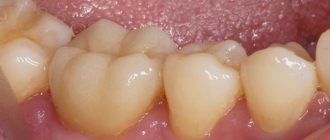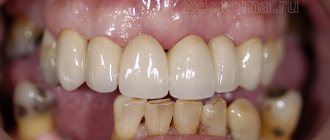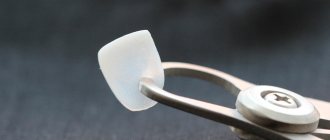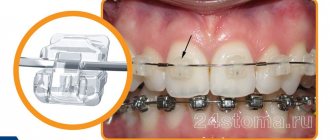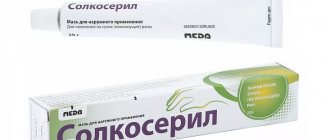The prosthetic procedure is the restoration of damaged or lost teeth, allowing not only to get a beautiful smile, but also to fully realize chewing functions. Various types of dental prosthetics used today make it possible to restore one tooth, several, and even the entire dentition.
First of all, from the point of view of patient convenience, dentures can be removable or non-removable. If it is necessary to replace one or more teeth, dentures are often permanent. In case of complete loss of dentition, previously only removable dentures were used, but today it is possible to install fixed dentures on implants.
The latest dental prosthetics
People have been aware of the need for dental prosthetics since ancient times. The manufacture of dentures was reduced to crafts from seashells, animal bones, precious stones and even wood. But all this dental prosthetics was used only to mask the resulting defect, rather than to restore chewing function. For example, the products of ancient dental jewelers served primarily social purposes, and only then practical ones. The richest people of Ancient Rome could decorate their smiles with gold only to demonstrate their status to others.
In modern dentistry, dentures are an important part of dental treatment. The production of dentures does not stand still and constantly offers new technologies, expanding the possibilities of using various materials. It is difficult to imagine a modern person at business negotiations or at dinner with friends, giving those around him a toothless smile. Therefore, dentistry pays special attention to proper dental prosthetics, which belongs to a separate area - orthopedics. Accordingly, the doctor who performs dental prosthetics is called an orthopedist. In some clinics, dental treatment and prosthetics are performed by one doctor who specializes in orthopedics.
Features of dental prosthetics
Each type of prosthetics has its own characteristics; let’s look briefly at each of them.
Prosthetics of anterior teeth
Requires great attention to the aesthetic side, as well as the shortest possible deadlines. This is due to the fact that few patients can afford to walk for a long time with an obvious aesthetic defect or a “hole” instead of a tooth. Also, prosthetics of the upper front teeth require the use of all-ceramic structures in order to avoid metal showing through the artificial enamel or exposing it in the gingival area.
Prosthetics of chewing teeth
Prosthetics of chewing teeth require more attention to the functional side of the issue. Here, metal-ceramics are acceptable, and in some cases even more preferable, since the strength of structures becomes more important than aesthetics. As for prosthetics on implants, it is advisable to use a two-stage technique, when the implant is first placed, and the crown is installed only after its complete osseointegration.
Prosthetics of the upper jaw teeth
If they are restored after removal, they may require a preliminary sinus lift. This is due to the close location of the maxillary sinuses (sinuses) near the roots of the upper lateral teeth. Sinus lifting is a type of bone grafting that allows you to lift the bottom of the maxillary sinus and fill the vacated space with bone tissue, which will be used to fix the titanium tooth root.
Metal and plastic
These are inexpensive crowns that have been placed on the front teeth for decades.
The metal base was covered with an inert synthetic. But time has shown the conventional aesthetics of the structures - over time, the coating darkened and the metal became visible. After a couple of years, a painful replacement of the prosthesis was required. Today, metal-plastic crowns are cheap and can be used for the restoration of molars. But their aesthetic life is maximum 3 years. Therefore, this option is recommended as temporary. Before permanent prosthetics during implantation or in other cases when it is impossible to install a permanent prosthesis immediately after treatment.
Why is it better not to postpone prosthetics?
Where there is no tooth, the chewing load is reduced, which leads to bone atrophy - a progressive process in which the alveolar ridge, where the teeth are located, as well as the jaw as a whole, decreases. With atrophy, the lower third of the face decreases, physiological, functional and aesthetic disturbances occur. Implant prosthetics stops bone atrophy.
The load of the lost tooth falls on the rest, which leads to rapid erosion of the enamel and an increased risk of caries. Over time, you can get several severely damaged teeth in the vicinity of the defect.
If a tooth is missing, its neighbors begin to shift towards the empty space, forming bite defects that disrupt the aesthetics of a smile and interfere with chewing food well. This can lead to problems with the gastrointestinal tract.
The beauty of the smile, the elasticity of the skin and the symmetry of the face suffer, since its soft tissues rest on the teeth, and if a tooth is lost, diction may deteriorate.
Implantation: indications and benefits
Implantation is the most advanced dental technique that allows you to insert a tooth in place of an extracted one.
- Implants eliminate dental defects of any location and extent.
- People quickly get used to the implants. There is no discomfort, no sensation of the presence of a foreign body in the oral cavity, no problems with chewing food.
- Before implantation, there is no need to grind and depulp adjacent teeth; they remain healthy.
- Implants do not need to be changed or adjusted. With proper implantation and personal hygiene, artificial roots can last a lifetime.
- Even under increased loads, there is no risk of implants falling out or loosening.
Types of dental prosthetics
What types of prosthetics are there and how do they differ from each other? Dentistry divides dentures into three categories: fixed, partially removable and removable prosthetics. Fixed dentures are:
Turn on adki
Essentially, these are the same fillings, but made in the laboratory using individual impressions, usually made of ceramics. They belong to non-removable dentures. They have maximum precision of fit and high aesthetics. Unlike a conventional filling, a ceramic inlay is more durable and completely invisible on the teeth.
Ceramic veneers
Fixed dentures in the form of thin ceramic plates covering the outer surface of the teeth. As a rule, this type of permanent dental prosthetics is used in the smile area to correct the shape and color of teeth.
Lumineers
Ultra-thin ceramic plates, with the help of which dental prosthetics do not require preliminary serious treatment of the teeth. Unlike veneers, lumineers can be removed, but the list of problems they can treat is very limited.
Dental crown
A cap that replaces the crown of a tooth and imitates its natural shape. The most common option for this type of denture.
Bridge prosthesis
A design of several artificial dental crowns attached to natural teeth or roots. A classic version of dental prosthetics. This category also includes an adhesive bridge, used as a temporary aesthetic structure.
Dental implant
A titanium “root” is implanted into the bone in place of a missing tooth, on which an artificial crown is installed.
All other designs are partially removable or completely removable dentures. These include:
Plate dentures
A prosthesis made of an acrylic or nylon base with artificial teeth placed on it. Can be completely removable and rest on the mucous membrane of the edentulous areas, jaws and palate. And also – partially removable with fixing elements on natural teeth. A complete removable plate denture supported by implants is the most popular and reliable type of implantation today in the absence of teeth.
Clasp dentures
Prostheses with a metal frame, which include devices that hold and unload the structure, arches and artificial teeth. The production of dentures of this type takes place in the laboratory.
Each type of prosthesis and method of dental prosthetics solves a specific functional and aesthetic problem, starting with the ugly color of teeth and ending with their complete absence.
When is it necessary to put a crown on a tooth: indications for restoring teeth with a crown
The need to place a crown on a tooth may arise in the following situations:
- The tooth is severely damaged by caries. If the natural crown of a tooth is damaged by more than 50% by caries, then it would be more correct to put a crown on the tooth rather than restore it with a filling. Large fillings do not withstand the chewing load well and may fall out or break, and the tooth may break along with the filling. If the root of the tooth is damaged, then it will have to be removed. By placing a crown on a decayed tooth, you have the opportunity to save it;
- The tooth is destroyed as a result of trauma. If the roots of a tooth were not affected by injury, it is possible to restore the tooth - it will be enough to put a crown on it;
- You can also put a crown on a tooth for aesthetic restoration: for example, if a tooth is chipped or its enamel has changed color, becoming gray or yellow, and this defect cannot be eliminated by classic whitening.
Doctors recommend placing temporary crowns to preserve teeth for patients with periodontitis. In this case, crowns prevent teeth from becoming loose and falling out.
In your case, do you need to put a crown on your tooth or is it possible to use another restoration method? The doctors of our dental clinic in Moscow, “Firadent,” can help you find the answer to this question. To make an appointment with our specialists, you just need to dial our dental clinic’s phone number!
Materials for dentures
Materials used in orthopedics have special requirements. They must be biologically compatible with human oral tissues and be resistant to saliva and food. Materials should not cause allergies, change taste, or have an odor. Their strength, resilience, elasticity and abrasion should be close to the tissues being replaced. In addition, an important requirement is the possible production of dentures from these construction materials, which are as close as possible in color and appearance to natural teeth and gums. Let's take a closer look at each of them.
Metal
The first metal used to make dentures was gold. Gold teeth had an absolute monopoly for 2,500 years. And even today you can still find owners of metal dentures made of gold. But today, modern dental prosthetics most often uses various metal alloys, usually as auxiliary materials. For example, when making crowns, a metal frame is first cast and then covered with a layer of ceramic. Thus, metal-ceramic dentures are created - the most popular in dentistry today.
Ceramics
The main advantage of ceramic dentures is that they are fully compatible with soft tissue, hypoallergenic and help create natural gum contours. In addition, ceramic structures can be painted in one of the shades that most accurately conveys the natural color of teeth.
Plastic
This type of material is used to create artificial teeth and bases for removable dentures. Dental laboratories use acrylic resin-based plastics to create acrylic dentures. And with the beginning of the use of non-acrylic polymers in dentistry, polyurethane and nylon dentures appeared.
Rules for caring for dentures
When installing any type of dentures, you must follow the oral care rules recommended by your dentist. They depend on what kind of dental prosthetics was performed. If removable dentures are installed:
- immediately after installing the structure, do not remove it for several days in a row at night, while eating, talking (even if it interferes), until the tissues get used to the pressure exerted on them;
- when the pain and discomfort from wearing the prosthesis go away, it can be removed at night; but modern construction materials make it possible to wear them constantly;
- Every morning and evening after removing the denture, it is washed with cold running water and cleaned with a soft toothbrush and toothpaste without abrasive;
- at night, the prosthesis can be placed in a special protective container or in a container with a disinfectant solution intended for long-term storage; it can be bought at the pharmacy in finished form or in the form of tablets that dissolve in water; clasp dentures with metal parts must be stored in a solution with anti-corrosion properties;
- after each meal, it is advisable to remove the denture and rinse it with water, as well as rinse your mouth;
- Once every six months, the denture can be taken to the dentist for professional cleaning;
- if severe pain, erosion, or inflammatory processes appear in the oral cavity, you should contact a dentist; In this case, it is necessary to install a removable dental prosthesis three hours before the appointment so that the doctor can see exactly what is happening.
Maintenance of the fixed structure:
- In the morning and evening, you need to brush your teeth with toothpaste without abrasive;
- after eating, rinse your mouth with boiled water or mouthwash, and also rinse the interdental spaces with an irrigator;
- It is better not to use dental floss - as a result of their use, the product may be damaged;
- Carry out professional cleaning every six months.
Technology and methods of dental prosthetics
The technology of dental prosthetics does not stand still, it is constantly evolving, outdated ineffective methods are becoming a thing of the past, more and more advanced techniques and the most modern materials are appearing. Modern technologies and methods of dental prosthetics involve the widespread use of computers at all stages from diagnostics (taking 3D X-rays) to the manufacture and installation of structures. New technologies in dental prosthetics are, for example, a CAD/CAM system that allows the production of high-precision orthopedic structures using 3D computer models by sawing on a milling machine from high-strength ceramics, while just a few years ago crowns and other prosthetics were made by casting ceramics on metal frames. Thanks to the latest technologies and methods in dental prosthetics, today it is possible to make prosthetics in one visit to the doctor, when the design is made not by a technician in a laboratory, but by a special ultra-modern and high-speed machine, on which the doctor himself models the prosthesis.
Five important questions about how to insert teeth
Before describing technologies for restoring lost teeth, we will briefly answer the most popular questions that interest almost all patients who are faced with the need for prosthetics for the first time.
- Do I need to replace teeth if I have lost them?
Dentists recommend doing this immediately and without fail. Even if the emptiness in the dentition is unnoticeable, do not delay your visit to the clinic. Lack of timely treatment leads to resorption of bone tissue, displacement of the dentition, deterioration of the bite, and can cause changes in the shape of the face and problems with the digestive system. - What teeth can be inserted?
Absolutely everything: natural incisors, canines, molars and premolars can be successfully replaced with dentures. - Does it hurt to put teeth in?
Many patients familiar with the methods of Soviet dentistry are concerned about the question of whether it hurts to insert teeth? We hasten to reassure you: modern methods of anesthesia make the treatment absolutely painless. - How long does it take to insert teeth?
It all depends on the treatment method, the efficiency of the doctors and the dental laboratory. Temporary teeth can be inserted in one visit; permanent dentures require more time. - What is the name of the doctor who inserts teeth?
The doctor who inserts teeth and performs prosthetics is an orthopedic dentist, but treatment and preparation for procedures is usually carried out by a whole team of specialists: dental surgeons, dental therapists, dental technicians.
Preparing teeth for prosthetics
Before the manufacture and installation of dentures, careful preparation for dental prosthetics must be carried out. First, any current oral problems such as tooth decay or gum disease such as periodontitis must be addressed. If some chronic diseases cannot be completely cured, it is necessary to put them into remission. Also, prosthetics may require preliminary orthodontic treatment, for example, if there is a severe malocclusion or there is not enough space to install an implant. Before aesthetic microprosthetics with veneers or lumineers, it is necessary to do whitening, and a procedure such as professional teeth cleaning will be required in any case. In addition to the above measures, an orthopedic consultation includes such preliminary steps as consulting a doctor, taking x-rays, drawing up a treatment plan and choosing the optimal type of prosthetics.
Oral examination
Any treatment process must begin with an examination. A preliminary examination allows you to determine the need for prosthetics, choose the optimal type of design and amount of work.
Examination of the oral cavity in dentistry Additional examination (instrumental, x-ray, etc.) provides information about the condition of the supporting teeth, periodontal tissue, bone tissue, the need for root canal treatment, and the possible presence of inflammatory elements at the tops of the root canals or in the bone.
This is an integral stage of successful prosthetics, as it allows not only to identify and eliminate hidden problems, but also to avoid possible complications in the future, after installation of the prosthesis .
Timing of dental prosthetics
The next pressing question that worries every patient is “How long does dental prosthetics take?” There are two main calculation criteria here: whether the participation of a dental technician is required in the manufacture of dentures and whether a break is necessary between the main stages of the procedure. Almost all types of orthopedic treatment discussed in this article involve the production of dentures in a dental laboratory using individual casts of the patient. This means that installation of the prosthesis will require two visits to the dentist, with a break necessary for the construction to be made in the laboratory. However, today an increasing number of clinics are acquiring the latest models of milling machines with the ability to instantly produce orthopedic structures using 3D computer models of casts. Thus, the time required for dental prosthetics is reduced to one visit to the dentist. As for dental prosthetics on implants, here you will have to prepare for a longer treatment, since several months (from four to six) necessary for the engraftment of the titanium root may pass between the implantation of the implant and the installation of a permanent crown on it.
How is an implant inserted?
The essence of this technique is to implant a titanium root into the jaw, on which a crown is subsequently installed. On average, implant healing takes from 2 to 6 months. During this time, a temporary orthopedic structure is installed for the patient’s convenience.
There are protocols for immediate implantation. Modern structures can be inserted after tooth extraction and immediately loaded with a prosthesis. Many patients are interested in whether it is painful to insert a dental implant. In fact, implants are installed quite quickly (15 - 20 minutes per tooth), and an injection of anesthesia allows you not to feel pain. If you have severe dental phobia, the doctor will suggest inserting teeth under anesthesia or sedation.
Stages of prosthetics
After all the preparatory procedures, the specialist proceeds directly to prosthetics, which also includes several stages.
- Preparing for installation. When prosthetics supported by implants, in some cases, preliminary bone augmentation is required. To fix a crown or dental bridge, it is necessary to depulpate, that is, remove the nerve, then fill the root and grind the surface. Before installing veneers and inlays, the doctor grinds down about 0.2 - 0.5 millimeters of dental tissue, while lumineers only need light grinding of the tooth shell.
- Making a prosthesis. Impressions of the jaw, X-rays and other necessary patient data are sent to the dental laboratory, based on which a design is created.
- Installation. The finished permanent prosthesis is adjusted to the desired size during fitting. The dentist adds highlights and shadows, adjusts the color and texture to optimally resemble the patient’s natural teeth.
Previously, depulpation was a mandatory point in the process of prosthetics, but in modern clinics doctors have different opinions about the advisability of the procedure. Removing the nerve relieves pain in the tooth area and increases its stability, but shortens the life of the tooth and accelerates tissue destruction. The specialist makes the decision on depulpation based on the diagnosis and the patient’s own feelings.
FAQ
— Should I be afraid of allergic reactions?
An allergy to dentures is possible, but it is quite rare. Before installation, the patient undergoes a predisposition test. Based on the results of a vegetative resonance study, an orthopedic doctor determines sensitivity to various materials used in prosthetics. This method is 90% reliable.
— Is it necessary to use fixing compounds when wearing removable dentures?
Removable structures are “sucked” to the surface of the oral cavity, but for additional fixation you can optionally use creams or powders.
— Is it possible to sleep with removable dentures?
In the first 2-3 weeks, dentists even recommend not removing the structure at night in order to speed up the adaptation process. After the adaptation period, the choice remains with the patient himself - place the prosthesis in a special solution before going to bed or leave it in the mouth.
— When there are no teeth at all, which prosthesis is better to put in?
For complete edentia, the best option is fixed dentures on implants or prosthetics using the All-on-4 method. High aesthetics and durability will be important advantages. As an economical option, you can consider an acrylic prosthesis or acry-free.
High-quality dental prosthetics
Unfortunately, the installation of dentures does not always go smoothly; sometimes incorrect dental prosthetics causes complications, and quite dangerous ones. However, it is necessary to clearly distinguish between discomfort, which invariably occurs after any serious dental intervention and is considered normal, and actual complications. If after the procedure for one, two or three days (depending on the type of prosthetics) there is slight bleeding in the area of the soft tissue incision, slight swelling or pain suppressed by painkillers, there is no need to sound the alarm, unless the pain is sharp and the bleeding not plentiful. If, within a few days after prosthetics, the tooth hurts very much, the bleeding does not stop, and the swelling does not subside, this means that the doctor made mistakes during dental prosthetics.
Which crown to choose
Most of all, patients are interested in the cost of crowns and their aesthetics. Of course, you can choose a prosthesis yourself, focusing on your financial capabilities and ideas about beauty. But it is better if a doctor does this. Before starting the restoration of the dentition, the dentist evaluates the condition of the root system, gums, mucous membrane, tissues of the root part and cervical area. When choosing a prosthetic method, it is important to exclude all contraindications. They differ depending on the method of tooth restoration. The most serious are diseases of the immune system, oncology, uncompensated diabetes mellitus and periodontal inflammation. The doctor’s task is to choose the safest prosthetic option for the patient and the one that best suits the clinical picture.
Dental prosthetics under anesthesia
Implant-supported prosthetics involve major surgery, so the operation is always performed under anesthesia. Patients often choose the most comfortable type of pain relief - sedation or general anesthesia. Local anesthesia is also effective, but some patients find it psychologically difficult to perceive unpleasant sounds and smells during the procedure.
Correct and high-quality installation of a crown or bridge should not cause severe pain. In this case, local anesthesia is used to alleviate discomfort during depulpation, grinding of the tooth and fixation of the structure.
When performing prosthetics with inlays and veneers, an injection of local anesthesia is used, since grinding down the dental tissue causes pain.
Metal ceramics
If it is necessary to replace molars, ceramics will not be suitable; the material is too fragile and will not withstand the increased load. Therefore, it is more reasonable to install metal-ceramic or zirconium crowns on chewing teeth. The last segment is more expensive. Therefore, many patients choose a metal cast crown coated with ceramics.
Modern frames are made only by casting. This ensures a tight fit of the crown in the remains of the natural tooth, preventing the entry of pathogenic microflora into the tooth.
Pain after prosthetics
Pain after dental prosthetics can mean prosthetic stomatitis, an inflammatory disease of the soft tissues at the point of contact of the crown and gums. This may occur due to the fact that the crown is put on too “tightly”, as a result of which it puts pressure on the gum, irritating it and injuring it. Pain may occur some time after the installation of a bridge, and one or both supporting teeth begin to hurt. This may mean that caries has gotten under the dentures and affected the supporting teeth. The reason for this is the loose fit of the crowns to the teeth, too large a gap between the bridge and the gum in the place where the tooth is missing, or the ingress of saliva during prosthetics.
Also, do not forget about such an insidious phenomenon as an allergy to the materials from which prostheses are made. If you suffer from at least one type of allergy, before getting prosthetics, you should check your body for compatibility with prosthetic materials.
Photos before and after prosthetics
Where to get teeth inserted in Moscow?
There are thousands of clinics in the capital, most of which offer almost all types of dental restoration (crowns, implants, removable and bridge dentures). Choosing a clinic is quite difficult, so we advise you to pay attention to important nuances. Study the clinic’s website: it should contain detailed information about specialists, treatment methods and technologies, as well as relevant diplomas and certificates. Read patient reviews about dentistry on third-party resources. Directly during the consultation, do not be afraid to ask questions and find out details. A good doctor will always give comprehensive information and offer various treatment options. The search engine on our website will help you find reliable dentistry.
Cost of dental prosthetics
Prices for dental prosthetics vary widely and depend on many factors. The first is, of course, the material. The more expensive it is, the higher the cost of dental prosthetics will be. The highest prices for dental prosthetics are ceramic veneers, which are classified as permanent dentures. The lowest cost is for removable dentures made of plastic, in particular acrylic. The cost of nylon dentures will be higher. The second factor is the amount of work. It is one thing if it is necessary to compensate for the loss of one tooth, and quite another if all are missing. For example, the price of clasp prosthetics in Moscow also depends on the qualifications of the orthopedist and dental technician, the use of modern technologies and equipment when creating an orthopedic design.
Zirconium dioxide and ceramics
Such dentures are flawless and are recommended for installation on the front teeth. The units are stronger than natural ones due to the stable zirconium frame, and the ceramic coating gives them a visual naturalness, ensuring correct light reflection.
But such a tooth crown is expensive. And it’s not always justified. Modern solid ceramics are close in strength to natural enamel. Therefore, in most cases, frameless ceramics, which are indistinguishable from natural units, are chosen for the restoration of the beauty area.
In addition, Cerec porcelain crowns for front teeth can be made within 1.5 hours; the price of this option is more affordable and its aesthetics are high. The artificial units created using innovative equipment will be flawless, you don’t need to get used to them - their parameters are calculated by a computer program taking into account the anatomical characteristics of a particular patient.
What types of dental prosthetics are best?
Every person who decides to undergo prosthetics, of course, is concerned with the pressing question: “What type of dental prosthetics is better?” Here you must first make a reservation about what kind of prosthetics we are talking about: the restoration of destroyed or damaged teeth or the replacement of a completely missing tooth (or several teeth). In the second case - when you need to restore a lost or extracted tooth - to the question “Which dental prosthetics should I choose?” There is only one answer: of course, implantation. However, here too you need to remember that there are pitfalls - for example, contraindications. As for the high price of dental implantation in Moscow, which scares off many patients and forces them to settle for less effective types of prosthetics, it is worth comparing the costs more carefully. The fact is that implants, if all installation rules are followed and with proper care, serve a person for a lifetime, and the crowns on them need to be changed no more often than once every ten, and sometimes fifteen years. As for, for example, bridges, the most popular alternative to implantation, they require replacement on average every five to seven years. In addition, the supporting teeth during bridge prosthetics tend to become loose, which also leads to their loss or destruction. In this state of affairs, the cost of implantation in the long term does not exceed the cost of bridge prosthetics.
However, in the case of prosthetics for partially, completely destroyed or lost teeth, your attending physician will tell you in detail how to choose the optimal treatment method for your specific situation. Remember that no conscientious doctor will remove a tooth and install an implant in its place if this tooth can be at least partially saved and restored using other types of prosthetics. Although an implant is the highest quality type of prosthetics, a native tooth, even if only the root remains, is still better.
Treatment prices: which teeth are better to insert on a limited budget
The cost of restoring one or more teeth depends on the treatment method and your budget. The most expensive treatment involves the use of implants. The cheapest thing is dental crowns.
| Insert teeth under anesthesia | An anesthesia injection costs on average 500 - 800 rubles. Treatment under general anesthesia - from 4,000 rubles (30 minutes). Sedation will cost from 1,500 rubles for half an hour. |
| Insert ceramic tooth | From 15 thousand rubles depending on the level of the clinic |
| Insert metal ceramics | From 9 thousand rubles. Depends on the metal alloy used |
| Insert a dental implant | 15 - 25 thousand for installing a budget brand of implants. 35 -50 thousand for a premium implant |
| Insert teeth completely | A removable denture on implants for one jaw costs on average from 120 to 250 thousand rubles (depending on the number of implanted implants and their brand). A regular removable denture will cost 25-50 thousand for one jaw |
| Insert zirconium teeth | From 25 thousand rubles depending on the level of the clinic. |
